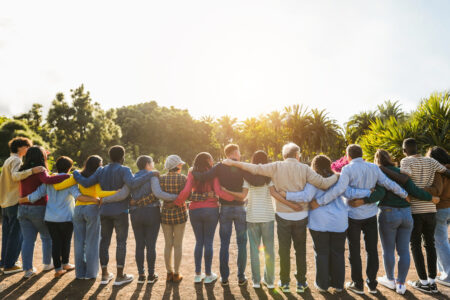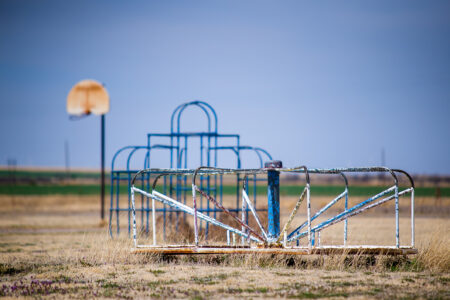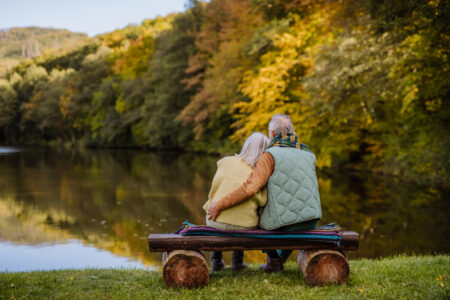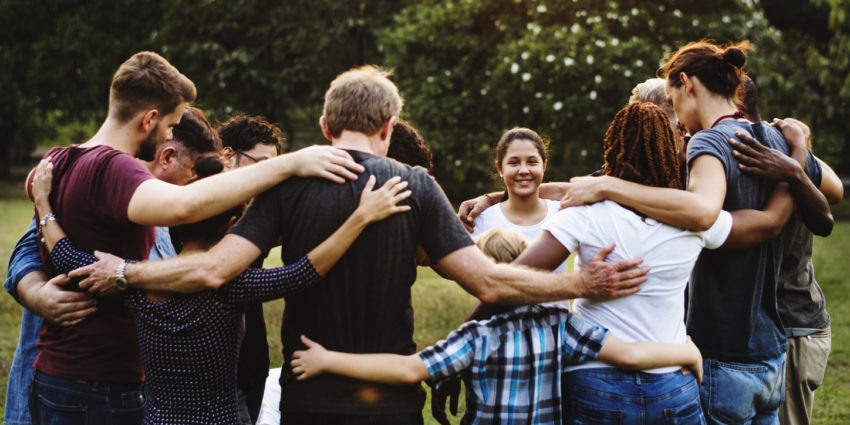
Share On Social!
This is part of the Salud America! The State of Latinos and Housing, Transportation, and Green Space: A Research Review »
Summary
Neighborhood development initiatives in Latino communities that rely upon “bottom-up” activism, a wide public-private partnership network, and “cultural brokers” have been effective at driving and maintaining long-term community change, especially in the context of environmental justice in Latino communities.
Green Space Access Is an Environmental Justice Issue
Over the past two decades, uneven access to green space has become an important environmental justice issue as awareness of its contribution to public health has become more widely recognized [33, 52].
In general, racial/ethnic minorities and low-income people have less access to maintained green spaces and recreational programs than those who are white or more affluent [90].
Studies of public and nonprofit funding for urban parks and recreation also show that low-income communities of color have far less to spend on parks and recreation, and have fewer non-profit resources as well [18, 91]. The smaller tax base in low-income communities has made it difficult for them to invest in these health-supporting environments, services, and programs [3], and the need for community activism to gain nonprofit support for green initiatives is great [33].
As ChangeLab Solutions puts it:
“State and local governments use capital improvement plans to decide which neighborhoods to prioritize for investments in the built environment and which transportation and open space improvement projects to fund. The prioritization decisions are typically made by elected officials and city staff. But the race and socioeconomic status of government officials are often not representative of the neighborhoods they serve.
“In addition, elected officials are often influenced by small groups of stakeholders with greater power and voice than the community at large. When the priorities of elected officials and interest groups are not representative of the broader community, decisions about capital improvement investments might be based on political influence and not on neighborhood need. Examples…are all too common…where the city’s low-income neighborhoods and neighborhoods of color receive the least funding for transportation and recreation spending” [2].
The New Environmental Justice: From ‘Bads’ to ‘Goods’
Studies of Latino communities in which green space initiatives have been successful reveal that there has been a transformation in the way environmental justice issues are handled to overcome these challenges [33, 88].
There has been a move away from hyperlocal, vertical organizations that aim to change the legal, bureaucratic, and technical “regulatory route” of governance to diversified, city-wide networks that include environmental justice organizations, mainstream environmental groups, nonprofits, foundations, and a breed of “environmental entrepreneurs” who seek to invest in win/win revitalization projects [33].
In the past, environmental justice (EJ) movements were centered on reactions to environmental “bads” in marginalized communities, mainly in cities but also in rural areas [92, 93].
In classic EJ politics, EJ organizations would mobilize the grassroots at the neighborhood level to defend communities against present or imminent threats to health or well-being arising from industrial development, land-use change, (i.e. building of a prison or utility site, for example) or toxic contamination.
Such movements relied upon legal strategies to force action from the government or the polluting industries, which had to comply with federal and state environmental regulations as well as environmental laws established in the 1960s and 70s. In many cases, EJ movements simply worked to delay or prevent undesirable land use, but did nothing to improve the communities, and the cost of the legal actions often used up the resources of grassroots EJ groups [33].
A more recent approach to EJ activism is one that instead of reacting to local, neighborhood-level hazards as they develop chooses to focuses on proactively restoring nature and producing new environmental “goods” in marginalized communities [15, 33, 88].
Such “goods” include spatially fixed amenities such as parks, green spaces, bike paths, trails, and community gardens, but can also be tied to development of new job opportunities, program funding, and investment options that revolve around the green economy [33].
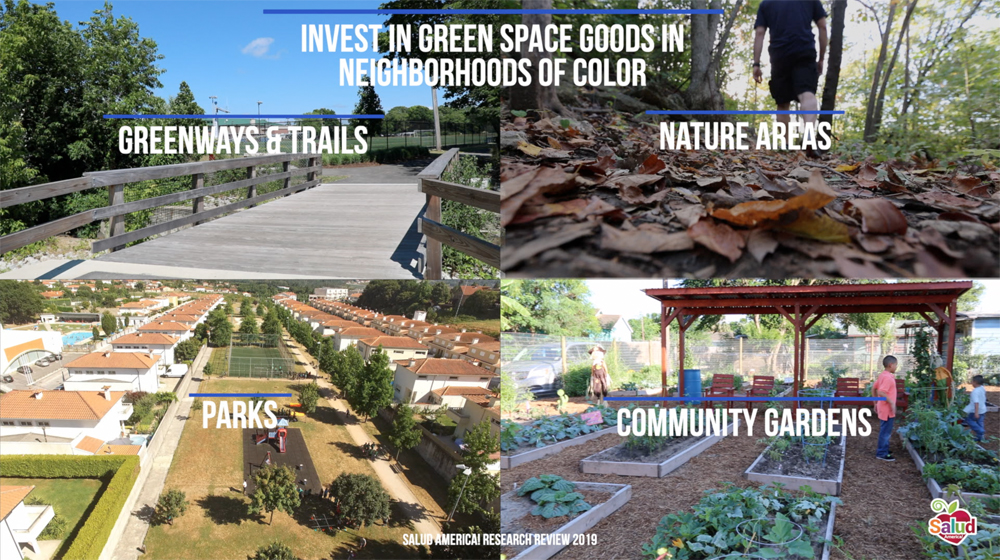 Environmental justice organizations using this model of EJ activism are able to work around the state by relying on networks of foundations, nonprofits, and small and large environmental NGOs; increasingly, green initiatives have taken the form of public-private partnerships that create new green space with shared governance [17, 52, 94].
Environmental justice organizations using this model of EJ activism are able to work around the state by relying on networks of foundations, nonprofits, and small and large environmental NGOs; increasingly, green initiatives have taken the form of public-private partnerships that create new green space with shared governance [17, 52, 94].
As E. D. Carter [33] explains with an example in his study of current EJ movements in Latino communities of Los Angeles:
“While the state parks agency, using funds from a special bond issue, ultimately purchased the land from a developer to create the park, the private Trust for Public Land brokered the deal and provided funds for environmental remediation, while coalitions of smaller organizations, some working within the Alianza de los Pueblos del Rio de Los Angeles coalition, provided legal expertise and grassroots support for the park.”
The ‘Cultural Brokers’ of New Environmental Justice
When looking specifically into the EJ networks that have developed in Latino communities, we find some interesting characteristics. As again described by Carter in his analysis of the creation of urban state parks in Downtown L.A. and Northeast L.A. in the early 2000s [33], networks of mostly Latino professionals came together to accomplish the necessary transactions that made the parks possible:
“Calling themselves the Alianza de los Pueblos del Rio de Los Angeles, the coalition was comprised of the Willie C. Velasquez Institute, which has strong connections with Latino political elites in the city; The City Project, which provided legal counsel; Mujeres de la Tierra, whose founder Irma Munoz, is well connected to mainstream environmental organizations; and the Anahuak Youth Soccer Association, whose leader, Raul Macias, as skillful at providing a grassroots ‘presence’ at planning meetings and demonstrations, mostly comprised of Latino children and parents from park-poor neighbourhoods of Northeast L.A.”
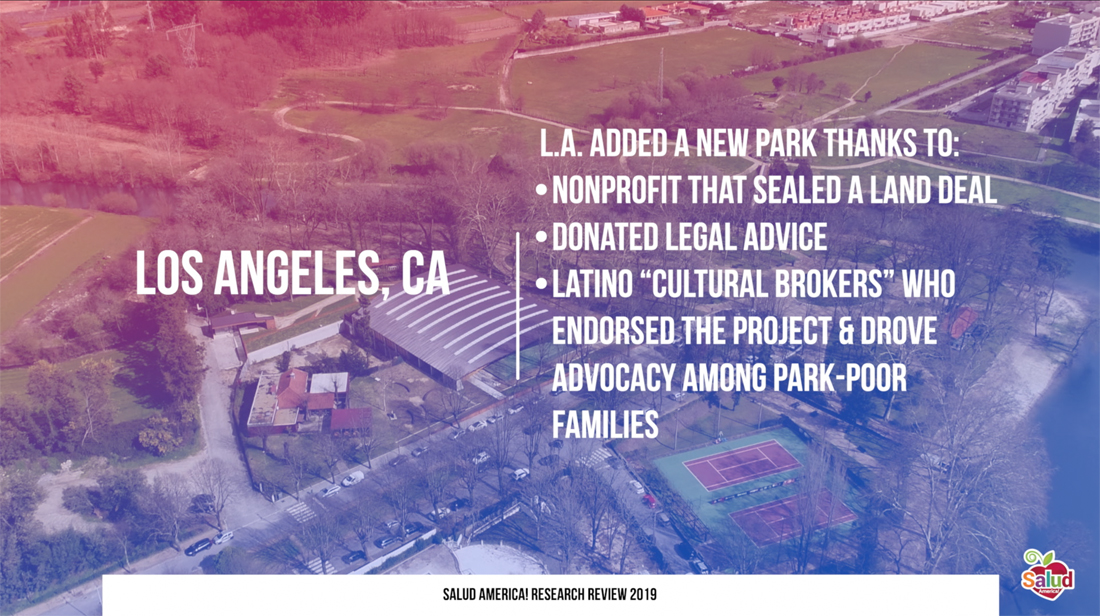 An important aspect of this network is that these professionals were able to serve as “cultural brokers” between mainstream, professional organizations and the grassroots, working-class Latino community, especially young people and children of immigrants [33, 88].
An important aspect of this network is that these professionals were able to serve as “cultural brokers” between mainstream, professional organizations and the grassroots, working-class Latino community, especially young people and children of immigrants [33, 88].
These individuals serve as cultural “translators” between groups who may lack experience or competence in communicating across cultures; the role of the “cultural broker” is to make development projects acceptable to the community they serve and to the developers handling the project.
The ability to pitch an environmental action within the right cultural frame for a specific audience has been crucial to achieving success for green space projects in Latino neighborhoods.
The Need for Greenways and Other Sustainable Transportation Routes
In addition to green spaces such as parks, there is a dire need for sustainable transportation routes in Latino communities.
However, there is often backlash to greenways, trails, bike lanes, bike shares, and other green transportation infrastructural projects in low-income neighborhoods. The backlash occurs because these investments are frequently seen as not actually benefitting the current residents in the neighborhood, but instead as improving the accessibility of these neighborhoods for more affluent populations and to spur gentrification [15, 95, 96].
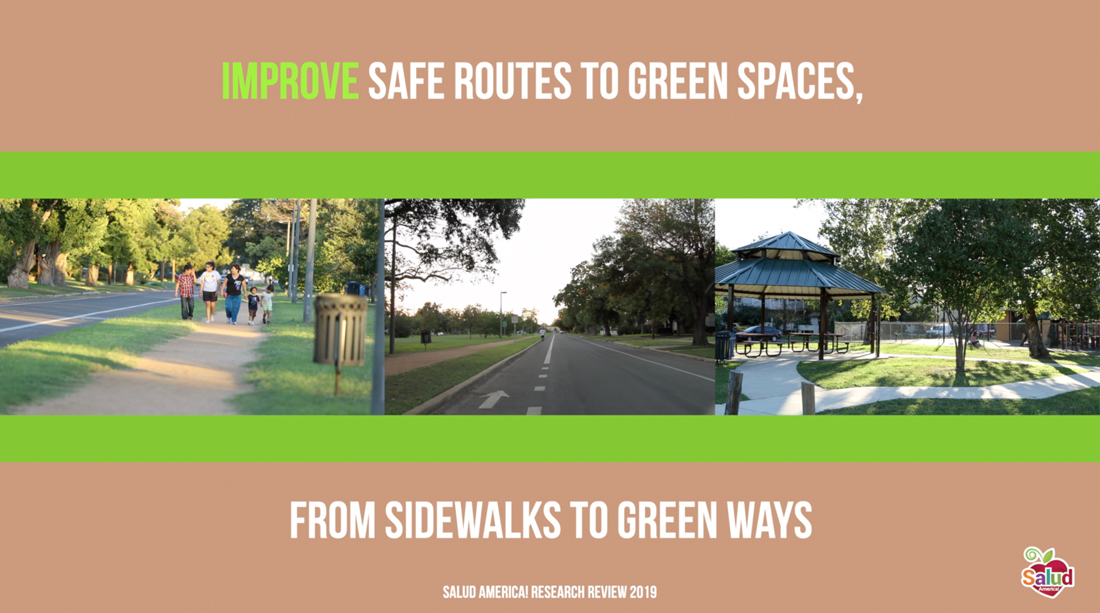 Jose Lopez, a Puerto Rican immigrant who moved to Chicago, is a cofounder of the Puerto Rican Cultural Center, which has led efforts to maintain the Humboldt Park neighborhood’s Puerto Rican identity.
Jose Lopez, a Puerto Rican immigrant who moved to Chicago, is a cofounder of the Puerto Rican Cultural Center, which has led efforts to maintain the Humboldt Park neighborhood’s Puerto Rican identity.
While overall public transport access isn’t a major issue in greater Humboldt Park, Lopez describes the transition in the Latino community’s acceptance of bike lanes in the area. In 2003, when the Chicago Department of Transportation first proposed extending bike lanes into Humboldt Park, the Puerto Rican Cultural Center “viewed the lanes as a symbol of gentrification and asked then 26th-ward alderman Billy Ocasio to veto the plan.”
But by 2012, several years after the opening of a bike-education center and retail outlet “Ciclo Urbano” in the neighborhood, educational and employment opportunities within the Latino community had changed the mindset enough that the Puerto Rican Cultural Center finally allowed the city to open the bike lanes.
As Lopez said, “By then, it was not something that was being imposed, but something that had more community acceptance” [15].
The Need for Community Support of Projects in Latino Neighborhoods
Fear of displacement, gentrification, and loss of culture is real and has often delayed sustainable transport projects in Latino communities [15, 52, 97].
It will thus be essential to gain community support before beginning these projects in Latino neighborhoods, so that such changes feel desired instead of imposed. “Cultural brokers” may be the key to success in this endeavor. In these cases, cultural brokers serve the essential role of linking grassroots activist groups with governance groups such as politicians and developers.
They help make sure the community understands how planned developments may serve the needs of community residents, and most importantly, they work to ensure that community desires are heard by the governing groups as well. Examples of neighborhood improvements that have taken place without displacement and to the benefit of the residents do exist, and have often been successful because cultural brokers ensured that the needs of the community were met.
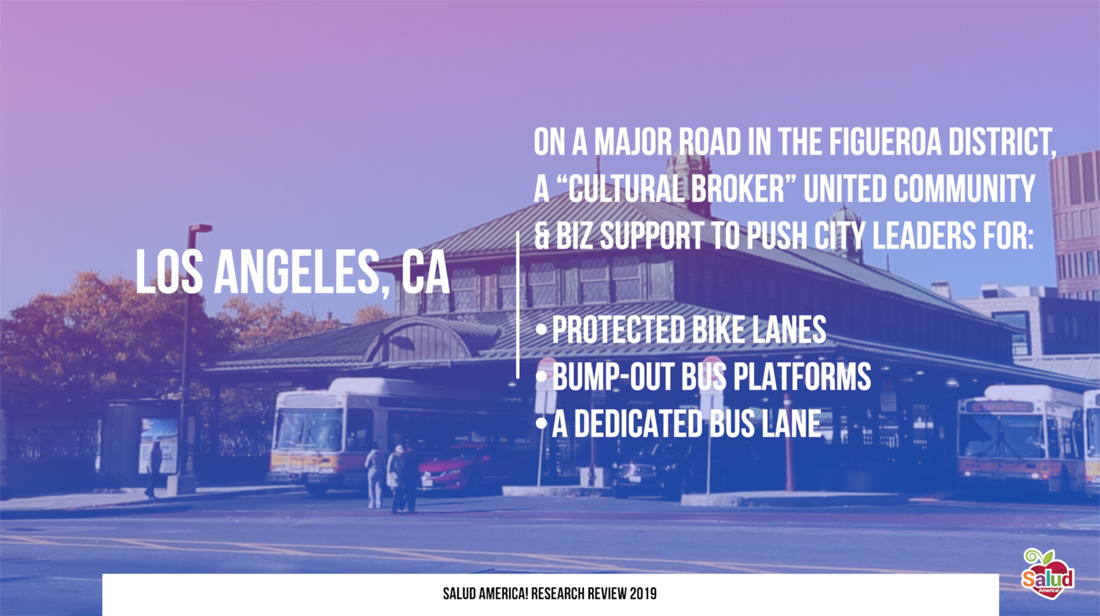 One such example has taken place in the Figueroa district of Los Angeles, where residents have played an active role in asking the city to improve transit, biking, and walking accessibility in the Figueroa corridor in a way that will improve the lives of the working class residents of the community [97].
One such example has taken place in the Figueroa district of Los Angeles, where residents have played an active role in asking the city to improve transit, biking, and walking accessibility in the Figueroa corridor in a way that will improve the lives of the working class residents of the community [97].
According to Nancy Ibrahim, who worked as the “cultural broker” with the residents of Figueroa for these changes, the 8-lane Figueroa Street corridor was zoned and developed for “affluent, transient students” to drive through in their cars, not for the families who live nearby and get around “by public transportation, by bicycle and by foot.”
As a result, Ibrahim helped push a plan through city council to dedicate three of Figueroa’s eight traffic lanes to protected bike lanes, bump-out bus platforms, and a dedicated bus lane, the idea of which stemmed from a community open house in which residents asked the city to dramatically improve transit, biking, and walking accessibility in the neighborhood [97].
The initiative nearly died due to push-back from large institutions including the University of Southern California, The National History Museum of Los Angeles, the California African American Museum, and a group of auto dealers who told local city council members they opposed the initiative due to worries over traffic congestion.
However, two powerful local Latino business representatives joined over 60 locals, mobilized by the Los Angeles County Bicycle Coalition, to testify at city council to support the plan before federal funding expired. This multicultural grassroots surge made it impossible for opponents of the plan to claim it was something locals didn’t want, and construction started in 2015.
As Ibrahim said:
“A lot of the development in this neighborhood has been going, so far, to separating—to making this community one where it’s not particularly desirable or healthy to get out of your car. The Figueroa corridor has been dominated by gentrifying interests that have resulted in a fast-food swamp. …It is so important that community residents have a say. …The new Figueroa is putting in a new level of accessibility and connectivity to working folks, including working poor folks, who contribute profoundly to what’s best about this neighborhood” [97].
Other examples include the transit-oriented development projects described earlier in detail at the MacArthur, Fruitvale, Boyle Heights, and Logan Heights locations, where huge amounts of community resident input resulted in significant change to the development plan, such that resident needs were heard and met [19, 51].
Affordable housing units were increased, and other amenities wanted by the community residents were added to the development plan at their request. Proactive, persistent grassroots activism with cultural brokers who had access to decision makers led to real change in these communities.
How to Successfully Engage Latino Communities
Civic engagement can take many forms, and there are many strategies for gathering residents for community activism.
Forms of engagement that have proven successful in Latino communities include [18]:
- Ongoing meetings at a regular time and place
- Distributing informational flyers
- A community survey
- Door-to-door engagement
- Making presentations at churches, small businesses, or other community-based institutions
- Training on specific issues of interest
- Social media engagement
Community residents are often the most effective organizers, especially when teamed with content experts or individuals who hold political power in the area.
In Lost Angeles, community-organizing and development of grassroots leadership is in integral component of the support provided by the East LA Community Corporation (ELACC), a nonprofit organization that works in the Boyle Heights and Unincorporated East Los Angeles. As part of their organization work, ELACC has developed an Affordable Housing 101 curriculum to train community members and grassroots leaders on the economics of affordable housing development, and they make many resources available on their website [18, 98].
How to Successfully Communicate with Latino Communities
Finally, a few key methods for communicating with Latino community members have proven effective [8].
Because policymakers, nonprofit groups, and businesses interested in improving the lives of Latinos in these areas will want to effectively reach these communities, research has been conducted to determine how best to communicate with the modern American Latino population. Small businesses, banks, and real estate brokers in particular may want to reach out to these new communities.
American Latinos are more likely than any other demographic to live in a multigenerational household, with 84% of Latino Millennials living in homes with children under 18. Latinos are increasingly bilingual by choice, with 81.4% speaking English well or exclusively, 54.2% identifying as bilingual, and only 18.2% Spanish-dominant. And finally, Latinos are huge consumers of mobile, and spend 25% more time on their mobile devices than do non-Latinos [8].
Therefore, to effectively reach the diverse Latino communities found across the United States, policymakers should attempt to use bilingual messaging, multigenerational targeting, and social media messaging.
Quick links from our Research Review »
SEE the GREEN SPACE FACT SHEET!
More from our Research Review »
- Executive Summary
- Introduction & Methods: Latino Housing, Transportation, and Green Space
- Research: Latino Families Burdened by Housing Costs, Eviction
- Research: Latino Rural Migration Led to Housing, Transportation Inequities
- Research: Latinos Face Big Public Transportation Challenges
- Research: Latino Communities Lack Accessible Green Space
- Strategy: How to Increase Affordable Housing in Latino Communities
- Strategy: How Transit-Oriented Development Benefit Latinos
- Strategy: Improve Public Transit to Improve Latino Quality of Life
- Strategy: Green Space Projects Can Boost Latino Health
- Strategy: Latino Community Involvement Can Spur Environmental Justice
- Policy Implications: Latino Housing, Transportation, and Green Space
- Future Research Needs: Latino Housing, Transportation, and Green Space
References for this section »
2. Calloway, E., & Hanley, C. (2018, October). 8 Policies That Have Contributed to Place-Based Health Disparities Across Generations. H. Retrieved from https://medium.com/changelab-solutions/8-policies-place-based-health-disparities-ea278adfda96
3. Woolf, S. H., Zimmerman, E., & Simon, S. (2013). The Inextricable Link Between Neighborhoods and Health. Department of Housing and Urban Development: PD&R EDGE.
8. Calderon, M. (2017). State of Hispanic Homeownership Report. Hispanic Wealth Project. Retrieved from https://nahrep.org/shhr/
17. Perkins, H. A. (2010). Green Spaces of Self-Interest Within Shared Urban Governance. Geography Compass, 4(3), 255–268.
18. Joassart-Marcelli, P., Wolch, J., & Salim, Z. (2011). Building the Healthy City: The Role of Nonprofits in Creating Active Urban Parks. Urban Geography, 32(5), 682–711.
19. Frey, W. H. (2010). Census Data: Blacks and Hispanics Take Different Segregation Paths, in State of Metropolitan America. Brookings: Brookings.
33. Carter, E. D. (2016). Environmental Justice 2.0: new Latino environmentalism in Los Angeles. Local Environment, 21(1), 3–23. doi:10.1080/13549839.2014.912622
52. Wolch, J. R., Byrne, J., & Newell, J. P. (2014). Urban green space, public health, and environmental justice: The challenge of making cities ‘just green enough’’.’ Landscape and Urban Planning, 125, 234–244. doi:10.1016/j.landurbplan.2014.01.017
88. Constante, A. (2018). In a fight for much-needed green spaces, these Latino advocates bring a winning formula. NBC News. Retrieved from https://www.nbcnews.com/news/latino/fight-much-needed-green-spaces-these-latino-advocates-bring-winning-n841436
90. Jennings, V., Gaither, C. J., & Gragg, R. S. (2012). Promoting Environmental Justice Through Urban Green Space Access: A Synopsis. Environmental Justice, 5(1), 1–7.
91. Joassart-Marcelli, P. (2010). Leveling the Playing Field? Urban Disparities in Funding for Local Parks and Recreation in the Los Angeles Region. Environment and Planning A: Economy and Space, 42(5), 1174–1192.
92. Bryant, B. (2003). History and Issues of the Environmental Justice Movement. In G. Visiglio & D. Whitelaw (Eds.), (pp. 3–24). Lanham, MD: Editors Rowman & Littlefield Publishers.
93. Pellow, D. N., & Brulle, R. J. (2005). Power, Justice and the Environment: A Critical Appraisal of the Environmental Justice Movement. Cambridge, MA: MIT Press.
94. Pincetl, S. (2003). Nonprofits and Park Provision in Los Angeles: An Exploration of the Rise of Governance Approaches to the Provision of Local Services. Social Science Quarterly, 84(4), 979–1001.
95. Hoffmann, M. L. (2016). Bike Lanes Are White Lanes Bicycle Advocacy and Urban Planning University of Nebraska Press.
96. Barajas, J. M. (2017). Bicycle Justice and Urban Transformation: Biking for All? (Vol. 83).
97. People for Bikes. (2015). Race, ethnicity, class, and protected bike lanes: An idea book for fairer cities. Retrieved from https://peopleforbikes.org/wp-content/uploads/2017/07/EquityReport2015.pdf
98. East L. A. Community Corporation. (2018). The East LA Community Corporation: Building a More Equitable Eastside. Retrieved from http://elacc.org/about-us/
By The Numbers
33
percent
of Latinos live within walking distance (<1 mile) of a park

